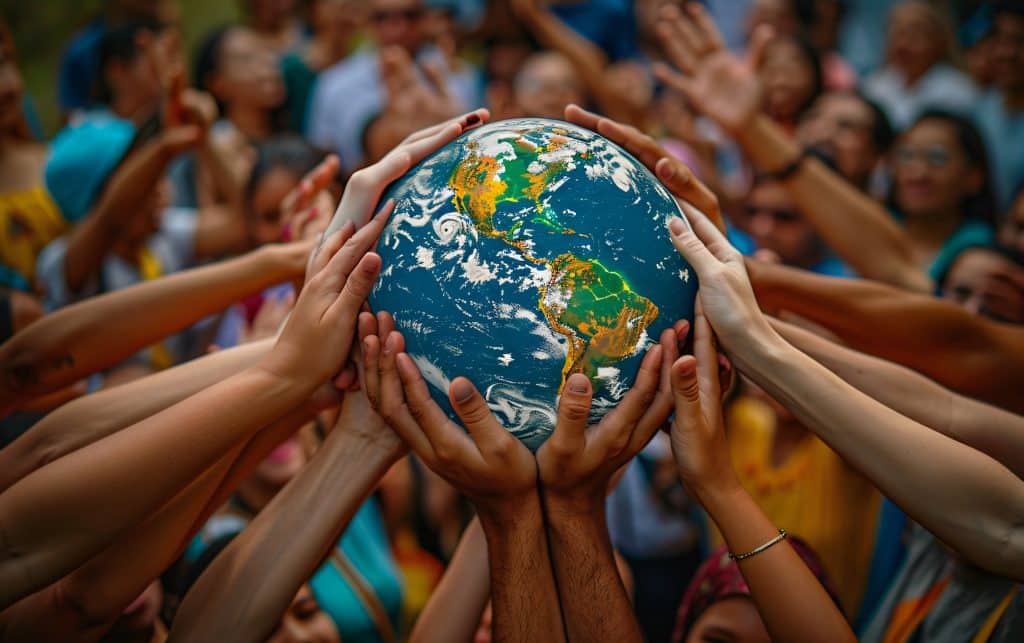Cultural Exchange: Old & New Worlds Historical Analysis

The historical cultural exchange between the Old and New Worlds profoundly reshaped global societies, economies, and ecosystems, initiating an era of unprecedented interconnectedness and lasting transformation across continents.
The **Cultural Exchange History** between the Old and New Worlds represents one of humanity’s most significant historical junctures. This monumental period, beginning in the late 15th century, fundamentally altered the trajectory of civilizations, economies, and ecological systems across continents. What were the immediate and long-term ramifications of this unprecedented global interaction?
The Dawn of Intercontinental Connection
The arrival of Europeans in the Americas, often termed the Age of Exploration, marked the genesis of a direct and sustained intercontinental connection. This era was not merely about geographical discovery but initiated a complex web of interactions that brought together vastly different cultures, technologies, and biological entities. The initial encounters were often fraught with misunderstanding and conflict, yet they laid the groundwork for an exchange that would define global history.
Prior to 1492, the Old World (Europe, Asia, Africa) and the New World (the Americas) had developed largely in isolation. Each possessed unique agricultural practices, social structures, political systems, and technological advancements. The subsequent contact led to an unparalleled fusion and collision of these disparate elements, creating an entirely new global dynamic. This period underscores the immense power of human movement and interaction to reshape the world.
Initial Encounters and Their Immediate Impact
The first points of contact were often characterized by European exploration parties meeting indigenous populations. These meetings, while sometimes peaceful, frequently escalated into territorial disputes and violence. European powers, driven by economic and political ambitions, quickly sought to establish dominance and exploit the resources of the newly encountered lands.
- Technological Disparity: European weaponry, including firearms and steel, often gave them a decisive advantage over indigenous technologies.
- Disease Transmission: The most devastating immediate impact was the introduction of Old World diseases, to which Native Americans had no immunity, leading to catastrophic population declines.
- Resource Exploitation: Europeans immediately began extracting valuable resources such as gold, silver, and furs, which fueled their economies and imperial expansion.
The Columbian Exchange: A Biological Revolution
Perhaps the most profound aspect of the cultural exchange was the Columbian Exchange, a term coined by historian Alfred W. Crosby. This refers to the widespread transfer of plants, animals, culture, human populations, technology, diseases, and ideas between the Americas, West Africa, and the Old World in the 15th and 16th centuries. It fundamentally reshaped the global ecosystem and human diets.
The exchange was a two-way street, though its impacts were unevenly distributed. Old World crops like wheat, rice, and coffee, along with livestock such as horses, cattle, and pigs, were introduced to the Americas. Conversely, New World crops like potatoes, maize (corn), tomatoes, and tobacco became staples in the Old World, dramatically altering agricultural practices and population growth.
Transformative Crops and Livestock
The introduction of American crops to Europe, Asia, and Africa had a revolutionary impact on global food security and population dynamics. Potatoes and maize, in particular, were calorie-rich and could be grown in diverse climates, contributing to significant population booms in various regions.
- Maize (Corn): Became a staple crop in Africa and parts of Asia, supporting larger populations.
- Potatoes: Revolutionized European agriculture, especially in Ireland and parts of Eastern Europe, providing a cheap and abundant food source.
- Tomatoes: Initially viewed with suspicion, they eventually became integral to Mediterranean cuisine.
From the Old World, horses transformed hunting, warfare, and transportation for many Native American tribes, particularly on the Great Plains. Cattle and pigs provided new sources of protein and also had significant ecological impacts, often outcompeting native species and altering landscapes.
Disease and Demography: A Catastrophic Imbalance

While the exchange of goods and ideas brought prosperity to some, it brought unparalleled devastation to others. The most tragic aspect of the cultural exchange was the introduction of Old World diseases such as smallpox, measles, influenza, and typhus to the Americas. Indigenous populations, having no prior exposure, lacked immunities to these pathogens.
The demographic impact was catastrophic. Estimates suggest that within a century of contact, Native American populations declined by 50% to 90%. This massive depopulation not only led to immense human suffering but also destabilized existing social structures, political systems, and cultural traditions, making resistance against European colonization even more challenging.
The Silent Killer: Smallpox and Beyond
Smallpox was particularly virulent and deadly, often preceding European settlers and weakening indigenous societies before direct military confrontation. The spread of disease was often unintentional, carried by explorers and traders, but its effects were undeniably instrumental in facilitating European conquest and settlement.
- Population Collapse: Entire villages and even empires, like the Aztec and Inca, were severely weakened by disease outbreaks.
- Social Disruption: The loss of elders, leaders, and knowledge keepers led to the disintegration of social cohesion and cultural transmission.
- Ecological Shifts: Vast tracts of land previously cultivated or managed by indigenous peoples reverted to wilderness, impacting local ecosystems.
Economic Transformation and Global Trade Networks
The cultural exchange profoundly altered global economic structures, leading to the establishment of vast new trade networks. The influx of New World Trade Routes silver and gold into Europe fueled the rise of mercantilism and capitalism, transforming European economies and financing further colonial expansion. The demand for labor in the Americas, particularly for resource extraction and plantation agriculture, led to the tragic transatlantic slave trade.
New commodities from the Americas, such as sugar, tobacco, and cotton, became highly sought after in Europe, creating new industries and driving further demand for colonial production. This era saw the emergence of a truly globalized economy, albeit one built on exploitation and unequal power dynamics.
The Rise of a Global Economy
The interconnectedness forged during this period laid the foundations for modern global trade. Goods, capital, and labor flowed across oceans on an unprecedented scale, linking continents in a complex system of production and consumption.
- Mercantilism: European powers sought to maximize exports and minimize imports, accumulating wealth through their colonies.
- Transatlantic Slave Trade: The demand for labor in the New World led to the forced migration of millions of Africans, profoundly shaping the demographics and cultures of the Americas.
- New Commodities: Sugar, tobacco, and cotton became critical cash crops, generating immense wealth for colonial powers and landowners.
Cultural Diffusion and Syncretism
Beyond biological and economic changes, the cultural exchange led to significant diffusion and syncretism of ideas, religions, languages, and artistic forms. European languages like Spanish, Portuguese, English, and French became dominant in the Americas, while indigenous languages faced suppression. Christianity, particularly Catholicism, was aggressively propagated, often replacing or blending with indigenous spiritual beliefs.
However, cultural exchange was not a one-way process. Indigenous knowledge of plants, agricultural techniques, and medicinal practices influenced European understanding. African cultural traditions, brought by enslaved peoples, profoundly shaped the music, cuisine, and religious practices of the Americas, particularly in the Caribbean and parts of South America. This blending of cultures created vibrant new identities and traditions.
A Mosaic of New Traditions
The interaction of diverse cultures resulted in unique new forms of expression and belief systems. This syncretism is evident in many aspects of modern American societies, from religious practices to culinary arts.
- Religious Syncretism: The blending of indigenous or African spiritual practices with Christianity, creating unique religious traditions like Vodou or Candomblé.
- Linguistic Impact: While European languages dominated, many indigenous words entered common usage, particularly for plants, animals, and geographical features.
- Artistic and Culinary Fusion: New artistic styles emerged, combining European techniques with indigenous motifs, and culinary traditions fused ingredients and cooking methods from all three continents.
Lasting Legacies and Contemporary Relevance
The historical cultural exchange between the Old and New Worlds continues to shape our present-day global landscape. The demographic patterns, economic disparities, and cultural identities of many nations are direct consequences of this period. Understanding this historical process is crucial for comprehending contemporary issues such as globalization, post-colonial identities, and environmental challenges.
The legacies of colonization, the transatlantic slave trade, and indigenous displacement are still actively debated and addressed in political, social, and academic spheres. This period serves as a powerful reminder of the interconnectedness of human history and the long-term impacts of intercontinental interactions.
Reflecting on a Shared Past
Examining this complex history allows for a deeper appreciation of the diverse foundations of modern societies and the ongoing process of cultural evolution. It highlights both the destructive and creative forces inherent in such massive global interactions.
- Global Interdependence: The foundations of our current globalized world were laid during this era of intense cultural exchange.
- Identity Formation: Many national and ethnic identities in the Americas are direct products of the mixing of European, Indigenous, and African ancestries and cultures.
- Historical Reckoning: Contemporary discussions around reparations, indigenous rights, and decolonization are directly linked to the consequences of this historical period.
| Key Aspect | Brief Description |
|---|---|
| Columbian Exchange | The widespread transfer of plants, animals, culture, human populations, technology, diseases, and ideas between the Americas, West Africa, and the Old World in the 15th and 16th centuries. |
| Demographic Collapse | Catastrophic decline of indigenous populations in the Americas due to Old World diseases like smallpox, to which they had no immunity. |
| Economic Transformation | Emergence of global trade networks, fueled by New World resources and leading to the rise of mercantilism, capitalism, and the transatlantic slave trade. |
| Cultural Syncretism | The blending of European, Indigenous, and African cultural elements, resulting in new languages, religions, artistic forms, and culinary traditions in the Americas. |
Frequently Asked Questions About Cultural Exchange History
The cultural exchange was initiated by European exploration and colonization of the Americas starting in the late 15th century. Christopher Columbus’s voyages are often cited as the symbolic beginning, opening direct routes between continents after millennia of separate development.
Key transfers included Old World diseases (smallpox, measles) to the Americas, and Old World animals (horses, cattle) and crops (wheat, rice) to the Americas. Conversely, New World crops (potatoes, maize, tomatoes) significantly impacted Old World diets and agriculture.
Indigenous populations suffered catastrophic declines due to Old World diseases, with estimates of 50-90% mortality. This depopulation severely weakened their societies, facilitated European conquest, and led to significant cultural and linguistic loss.
The exchange spurred the development of a global economy, fueled by New World resources like silver and gold. It also led to the transatlantic slave trade to meet labor demands for plantation agriculture, profoundly reshaping global economic and social structures.
Absolutely. The legacies of colonization, the transatlantic slave trade, and cultural blending continue to shape modern demographics, economic disparities, political landscapes, and cultural identities across the globe, influencing ongoing discussions on history and society.
Impact and Implications
The historical analysis of the cultural exchange between the Old and New Worlds reveals a rich and often paradoxical narrative of innovation, domination, and adaptation. This period not only reshaped economies and populations but also laid the groundwork for modern globalization and cultural hybridization. Every artistic tradition, linguistic evolution, and culinary fusion carries echoes of that transformative era.
Today, the legacies of these exchanges are visible in global migration patterns, trade systems, and social hierarchies. The ongoing pursuit of decolonization and historical justice underscores the importance of understanding how cultural transfer both connected and divided civilizations. By revisiting these roots, societies can better navigate the ethical and political questions that define the 21st century.
For a deeper exploration of how cultural contact continues to shape human understanding and cooperation, the article on cultural exchange by Worldpackers offers a compelling perspective on how interaction and learning across borders can foster empathy, equality, and sustainable global development. The echoes of the past remain, but how we interpret and act upon them will define our collective future.